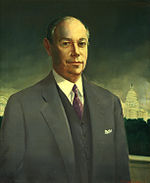United States Senate election in Nevada, 1952
|
|
|||||||||||||||||||||||||||||||||||||
|---|---|---|---|---|---|---|---|---|---|---|---|---|---|---|---|---|---|---|---|---|---|---|---|---|---|---|---|---|---|---|---|---|---|---|---|---|---|
|
|||||||||||||||||||||||||||||||||||||
|
36 of the 96 seats in the United States Senate 49 seats needed for a majority |
|||||||||||||||||||||||||||||||||||||
|
|||||||||||||||||||||||||||||||||||||

Republican hold
Republican gain
Democratic hold
Democratic gain
|
|||||||||||||||||||||||||||||||||||||
|
|||||||||||||||||||||||||||||||||||||
The United States Senate elections of 1952 was an election for the United States Senate which coincided with the election of Dwight D. Eisenhower to the presidency by a large margin. The Republicans managed to make a net gain of two seats, which was reduced to one when Wayne Morse (R-OR) became an independent. The Republicans held a 49 to 47 seat majority after Morse's switch. This election was the second time in history (after 1932) that the party in power lost their majority and the Senate Majority Leader lost his own re-election bid. (In addition, this was the second consecutive election in which a sitting Senate leader lost his seat.)
*I1@: Wayne Morse of Oregon, who was not up for election this year, changed parties from Republican to Independent in the next Congress.
All elections are for the Class 1 seats, unless otherwise indicated.
...
Wikipedia


